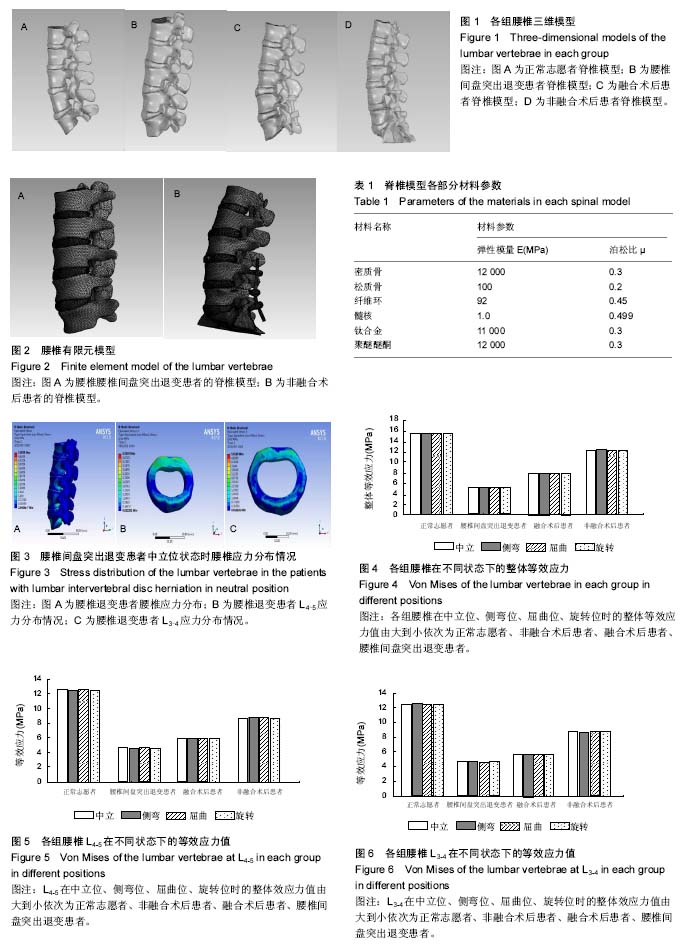| [1] Rohlmann A, Zander T, Schmidt H, et al. Analysis of the influence of disc degeneration on the mechanical behavior of a lumbar motion segment using the finite element method. J Biomech. 2006;39(13):2484-2490. [2] Miller J, Schmatz C, Schultz A. Lumbar disc degeneration: correlation with age, sex, and spine level in 600 autopsy specimens. Spine. 1988;13:173-178.[3] 王湘江. 新型腰椎-椎弓根动态内固定系统的建模与有限元分析[D]. 南华大学, 2010.[4] 张健,王文军.经椎旁肌间隙入路Hybri技术治疗腰椎间盘突出症临床分析[J].中南医学科学杂志,2015,43(2):160-164.[5] 郑佳状,张亨闰.经椎弓根Dynesys 动态固定治疗腰椎退变性疾病[J].重庆医学,2014,43(18):2278-2281.[6] 刘先哲,杨闻,杨述华. 腰椎非融合技术-Dynesys后路动态稳定系统临床应用研究[J]. 中国骨与关节外科, 2009, 2(2):165-167.[7] 李尔楠,叶启彬,匡正达. 脊柱非融合内固定系统在腰椎退行性疾病治疗中的应用进展[J].检验医学与临床, 2014,11(24): 3496-3498.[8] 李贤坤,武明鑫,谭志宏,等.单侧与双侧椎弓根螺钉固定后路椎间融合术后早期相邻节段退变的比较情况[J].广东医学院学报, 2014,32(4)::467-469.[9] Cheh G, Bridwell KH, Lenke LG, et al. Adjacent segment disease followinglumbar/thoracolumbar fusion with pedicle screw instrumentation: a minimum 5-year follow-up.Spine (Phila Pa 1976).2007;32(20):2253-2257.[10] 凌仕勇,贾连顺.融合与非融合治疗腰椎管狭窄症疗效和安全性对比[J].现代仪器与医疗,2016,22(3):31-33.[11] Cheh G, Bridwell KH, Lenke LG, et al. Adjacent segment disease following lumbar/thoracolumbar fusion with pedicle screw instrumentation: a minimum 5-year follow-up. Spine (Phila Pa 1976). 2007;32(20): 2253-2257.[12] Sonntag VK, Marciano FF. Is fusion indicated for lumbar spinal disorders? Spine. 1995; 20(24 Suppl):138S-142S.[13] Erbulut DU, Zafarparandeh I, Hassan CR, et al. Determination of the biomechanical effect of an interspinous process device on implanted and adjacent lumbar spinal segments using a hybrid testing protocol: a finite-element study. J Neurosurg. 2015;23(2): 200-208.[14] Boos N, Webb JK. Pedicle screw fixation in spinal disorders: a European view. Eur Spine J. 1997; 6: 2-18.[15] Gibson JN, Grant IC, Waddell G. The Cochrane review of surgery for lumbar disc prolapse and degenerative lumbar spondylosis. Spine. 1999;24: 1820-1832.[16] 张阳,李放. Dynesys动态固定系统与腰椎相邻节段退变的研究进展[J]. 中国骨与关节杂志, 2013,2(6):358-360.[17] 苏楠,杨雍,王炳强,等. Bacfuse棘突间撑开装置是否为高龄腰椎管狭窄症患者的又一选择[J]. 北京医学, 2016,38(7): 643-647.[18] 黎俊,瞿玉兴.动态固定技术治疗腰椎退行性病变的应用进展[J].颈腰痛杂志,2015,36(5):420-422.[19] Schmoelz W, Huber JF, Nydegger T, et al. Influence of a dynamic stabilisation system on load bearing of a bridged disc: an in vitro study of intradiscal pressure. Eur Spine J. 2006; 15(8):1276-1285.[20] Rohlmann A, Zander T, Schmidt H, et al. Analysis of the influence of disc degeneration on the mechanical behavior of a lumbar motion segment using the finite element method. J Biomech. 2005;28-34.[21] 王莹. 脊柱腰段三维有限元模型的构建与分析[D]. 西安电子科技大学, 2013.[22] 覃春钰. 人体脊椎腰段的三维模型构建及有限元力学分析[D]. 西安电子科技大学, 2014.[23] 柯国柱,胡立生.腰椎后路椎间融合术对邻近节段退行性变的影响分析[J]. 医学理论与实践,2015,28(20) :2789-2790.[24] 符从雅, 占朝澎, 郑继祖.腰椎多节段椎管狭窄合并椎间盘突出症的手术疗效[J].医学理论与实践,2014, 27(14) :1887-1889.[25] Chen XL, Guan L, Liu YZ, et al. Interspinous dynamic stabilization adjacent to fusion versus double-segment fusion for treatment of lumbar degenerative disease with a minimum follow-up of three years. Int Orthop. 2016;40(6):1275-1283.[26] Lu K, Liliang PC, Wang HK, et al. Reduction in adjacent segment degeneration after multilevel posterior lumbar interbody fusion with proximal DIAM implantation. J Neurosurg Spine. 2015;23(2):190-196.[27] 郭立新,陈威,刘学勇. 基于有限元模型的人体损伤脊柱的动态特性分析[J]. 东北大学学报, 2006,26(9):826-839.[28] Seidel H, Bluthner R, Hinz B. Application of finite element models to predict forces acting on the lumbar spine during whole body vibration. Clin Biomech. 2001; 16: S57-S63.[29] Helgeson MD, Bevevino AJ, Hilibrand AS. Update on the evidence for adjacent segment degenerative and disease. Spine J. 2013;13(3): 342-351.[30] Saavedra-Pozo FM, Deusdara RA, Benzel EC. Adjacent segment disease perspective and review of the literature. Ochsner J. 2014;14(1): 78-83. [31] 丁立祥,陈迎春,张亘瑷,等. 后路动态稳定系统内固定治疗腰椎间盘突出症的稳定性评价[J].中国组织工程研究, 2013,17(22): 4123-4129.[32] 朱小广,丁亮华,姜世涛,等. 腰椎后路经椎弓根动态固定系统研究新进展[J]. 中国脊柱脊髓杂志,2011,21(3):252-255.[33] 陈兵乾,张烽. 腰椎椎间融合术的研究进展[J].脊柱外科杂志, 2007,5(5):308-312. [34] Liu K, Sun W, Lu Q, et al. A cost-utility analysis of Dynesys dynamic stabilization versus instrumented fusion for the treatment of degenerative lumbar spine diseases. J Orthop Sci. 2017;22(6):982-987. [35] Seki S, Hirano N, Matsushita I, et al. Lumbar spine surgery in patients with rheumatoid arthritis (RA): what affects the outcomes.Spine J. 2017. pii: S1529-9430(17)30304-2.[36] Bouras T, Zairi F, Loufardaki M, et al. Which functional outcome parameters correlate better with elderly patients' satisfaction after non-fusion lumbar spine surgery? J Neurosurg Sci. 2017. doi: 10.23736/S0390-5616.17.03977-7.[37] Nomura H. A novel strategy of non-fusion instrumentation with coflex interlaminar stabilization after decompression for lumbar spinal stenosis.J Spine Surg. 2016;2(2):149-153.[38] Kim DH, Lee N, Shin DA, et al. Matched comparison of fusion rates between hydroxyapatite demineralized bone matrix and autograft in lumbar interbody fusion. J Korean Neurosurg Soc. 2016;59(4):363-367.[39] Lee SE, Jahng TA, Kim HJ. Clinical experiences of non-fusion dynamic stabilization surgery for adjacent segmental pathology after lumbar fusion. Int J Spine Surg. 2016;10:8. [40] Huang W, Chang Z, Song R, et al. Non-fusion procedure using PEEK rod systems for lumbar degenerative diseases: clinical experience with a 2-year follow-up.BMC Musculoskelet Disord. 2016;17:53. [41] Chou PH, Ma HL, Liu CL, et al. Is removal of the implants needed after fixation of burst fractures of the thoracolumbar and lumbar spine without fusion? A retrospective evaluation of radiological and functional outcomes.Bone Joint J. 2016; 98-B(1):109-116. [42] Lee SE, Jahng TA, Kim HJ. Hybrid surgery combined with dynamic stabilization system and fusion for the multilevel degenerative disease of the lumbosacral spine. Int J Spine Surg. 2015;9:45. |
.jpg)

.jpg)